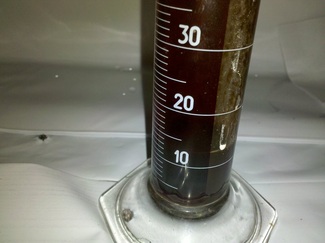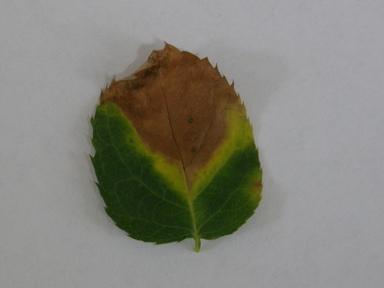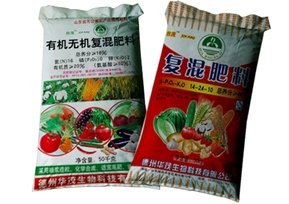Fertilizer Properites

A fertilizer is any inorganic or organic material, synthetic or natural, that when applied to the soil, gives plants nutrients that are essential for their growth. Nitrogen (N), Phosphorous (P) and Potassium (K) -- also known as NPK -- are the three macronutrients that fertilizers provide for the plants. Sulfur (S), Calcium (Ca), and Magnesium (Mg) are the secondary nutrients found in fertilizers, while Boron (B), Cobalt (Co), Copper (Cu), Iron (Fe), Manganese (Mn), Molybdenum (Mo), and Zinc (Zn) are the micronutrients. The main reason why Nitrogen, Phosphorous, and Potassium are considered to be the most important of the nutrients is because they provide the right nutrients that enable plant growth. For the plant to grow to its full potential, its owner has to know how much of each nutrient is already in the soil and then buy the fertilizer with the correct NPK ratio. However, although some fertilizers only contain these three main nutrients, other elements, called trace elements, are also added, and provide the plants with extra nutrients to keep them healthy. The reason why some fertilizers do not provide these trace elements is because most soils, if taken care properly, already contain them in abundance.
Consequences

If the plant is over-fertilized, it will undergo what is known as leaf scorch, in which the plant tissues, especially in the leaf margins and tips, start gaining a yellow color and/or become brown. Also known as fertilizer burn, this occurs when an excess of a fertilizer is used on the plant, causing there to be an excess of unwanted nutrients, usually of nitrogen salts. However, there is a treatment for the burnt plants; if the leaf is already scorched, the soil can be washed with water to flush out excess salts. Moreover, to prevent the fertilizer burn from happening, dilute or controlled-release fertilizers should be used.
The proportion of NPK is always available on the fertilizer bags. Even though the macronutrients are usually the main constituents of the fertilizers, they sometimes compose only 40% of the fertilizer; the rest is made up of mostly ballast or other nutrients. Ballast does not effect on the plant’s growth, but provides a timed release of ingredients and ease of material handling.
The proportion of NPK is always available on the fertilizer bags. Even though the macronutrients are usually the main constituents of the fertilizers, they sometimes compose only 40% of the fertilizer; the rest is made up of mostly ballast or other nutrients. Ballast does not effect on the plant’s growth, but provides a timed release of ingredients and ease of material handling.
How does it work?
Fertilizers have the simple objective of providing important chemicals that are pertinent for plant growth. Each of the NPK elements (Nitrogen, Phosphorus, and Potassium), provide plants with specific supplements, which help its growth.
Nitrogen provides the plants with rapid growth and vividly green leaves. Nitrogen is extremely important in plants because amino acids are formed from nitrogen – and, subsequently, enzymes and protein are made. Protein is the building block of life, and, since they are composed of enzymes (made of amino acids), plants could not exist without nitrogen. When applied at the correct timing, nitrogen will provide the plant with a growth boost – and is generally most efficient when applied early in the season. This is due to the fact that, if nitrogen is applied close to the blooming time, some blossoms may be sacrificed and the plant may become too exuberant, thus affecting the product. However, if nitrogen is not used in the right amounts, the leaves might become yellow and curly, and growth may be halted.
Phosphorous is needed in the plant since it promotes strong blooms and healthy plant cells. Plants cannot live without phosphorous due to the fact that they are the key element in the cell membranes; without phosphorous, phospholipids would not exist, and plant cells would not exist. Fertilizers with a high phosphorous ratio should be applied prior to blooming, in order to guarantee healthy blooms with strong colors. If phosphorous is not added to the plants, then the veins of the plant might start to become purple.
Potassium serves to construct a strong and healthy root system, to guarantee the plant’s growth and maintain health. For large plants, that require a tremendous quantity of roots, Potassium is extremely important because it will ensure that these plants have the correct root system to assure its growth. Potassium is also extremely important because it is responsible for up to 2% of the plant’s mass, and is essential for the metabolism. If there is a lack of potassium, the plant will not develop properly and it will have a poor health.
Nitrogen provides the plants with rapid growth and vividly green leaves. Nitrogen is extremely important in plants because amino acids are formed from nitrogen – and, subsequently, enzymes and protein are made. Protein is the building block of life, and, since they are composed of enzymes (made of amino acids), plants could not exist without nitrogen. When applied at the correct timing, nitrogen will provide the plant with a growth boost – and is generally most efficient when applied early in the season. This is due to the fact that, if nitrogen is applied close to the blooming time, some blossoms may be sacrificed and the plant may become too exuberant, thus affecting the product. However, if nitrogen is not used in the right amounts, the leaves might become yellow and curly, and growth may be halted.
Phosphorous is needed in the plant since it promotes strong blooms and healthy plant cells. Plants cannot live without phosphorous due to the fact that they are the key element in the cell membranes; without phosphorous, phospholipids would not exist, and plant cells would not exist. Fertilizers with a high phosphorous ratio should be applied prior to blooming, in order to guarantee healthy blooms with strong colors. If phosphorous is not added to the plants, then the veins of the plant might start to become purple.
Potassium serves to construct a strong and healthy root system, to guarantee the plant’s growth and maintain health. For large plants, that require a tremendous quantity of roots, Potassium is extremely important because it will ensure that these plants have the correct root system to assure its growth. Potassium is also extremely important because it is responsible for up to 2% of the plant’s mass, and is essential for the metabolism. If there is a lack of potassium, the plant will not develop properly and it will have a poor health.
Types

Inorganic Fertilizer: Inorganic Fertilizers are either synthetic or artificial fertilizers. Their main purpose is to save plants, which are dying due to a lack of nutrients. They promptly provide the plants with the nutrients. The fertilizer is synthesized by the Haber-Bosch process, which immediately produces ammonia – essential to dying plants.
Organic Fertilizer: Different from other fertilizers, organic fertilizers are not created by mixing chemicals together. Instead, natural ingredients containing macronutrients, secondary nutrients, and micronutrients, are used. Some examples of organic fertilizers include: chicken manure, blood, and bone meal. However, the main concern of organic fertilizers is to get the nutrient ratio wrong, which affects the plant’s growth. Still, plants accept organic fertilizers better due to the fact that they are made by nature and are now being used more frequently to help the environment.
Plant-Specific Fertilizers: Plant-Specific Fertilizers serve to provide nutrients to a specific type of plant.
These fertilizers exist because some plants require a specific ratio of nutrients, which may not be available in normal fertilizers. If a conventional fertilizer is used instead of a plant-specific one, plants may over-fertilize or under-fertilize, none of which are good for the plant.
Liquid Fertilizer: Liquid fertilizers are extremely conventional due to the fact that they can simply be added to the water and the rose, and its nutrients are delivered directly into the roots. Yet, liquid fertilizers have a short-term effect, and have to be constantly reapplied. Due to this, liquid fertilizers are not economically viable to be used in a huge lawn or plantation, since it requires a significant amount of time and money.
Time Release Fertilizer: Time release fertilizers are the most widely used fertilizer in contemporary society, due to the fact that it releases the fertilizer during a certain period of time – usually from 2 to 6 months. This has positive effects in plants because it reduces the probability that they will get burned, since they do not receive all nutrients at once. Furthermore, the deposition of nutrients is accelerated in the presence of water; therefore, it works best in warm and moist weather. Yet, the only problem of this fertilizer is that it is more expensive than the traditional ones.
Fertilizer with Pesticides: The objective of using this fertilizer is not only to supply the plants with nutrients, but also to protect them from dangerous pests. This is cheaper than buying the two products separately. However, the quantity of pesticides in the fertilizer has to be controlled meticulously, so that the plants are not killed.
Organic Fertilizer: Different from other fertilizers, organic fertilizers are not created by mixing chemicals together. Instead, natural ingredients containing macronutrients, secondary nutrients, and micronutrients, are used. Some examples of organic fertilizers include: chicken manure, blood, and bone meal. However, the main concern of organic fertilizers is to get the nutrient ratio wrong, which affects the plant’s growth. Still, plants accept organic fertilizers better due to the fact that they are made by nature and are now being used more frequently to help the environment.
Plant-Specific Fertilizers: Plant-Specific Fertilizers serve to provide nutrients to a specific type of plant.
These fertilizers exist because some plants require a specific ratio of nutrients, which may not be available in normal fertilizers. If a conventional fertilizer is used instead of a plant-specific one, plants may over-fertilize or under-fertilize, none of which are good for the plant.
Liquid Fertilizer: Liquid fertilizers are extremely conventional due to the fact that they can simply be added to the water and the rose, and its nutrients are delivered directly into the roots. Yet, liquid fertilizers have a short-term effect, and have to be constantly reapplied. Due to this, liquid fertilizers are not economically viable to be used in a huge lawn or plantation, since it requires a significant amount of time and money.
Time Release Fertilizer: Time release fertilizers are the most widely used fertilizer in contemporary society, due to the fact that it releases the fertilizer during a certain period of time – usually from 2 to 6 months. This has positive effects in plants because it reduces the probability that they will get burned, since they do not receive all nutrients at once. Furthermore, the deposition of nutrients is accelerated in the presence of water; therefore, it works best in warm and moist weather. Yet, the only problem of this fertilizer is that it is more expensive than the traditional ones.
Fertilizer with Pesticides: The objective of using this fertilizer is not only to supply the plants with nutrients, but also to protect them from dangerous pests. This is cheaper than buying the two products separately. However, the quantity of pesticides in the fertilizer has to be controlled meticulously, so that the plants are not killed.
